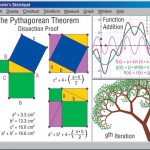Science teaching has been undergoing changes as technology and new teaching methods are being implemented in the classroom. Resnick & Wilensky (1999) suggest that incorporating the notion of levels into teaching will help to instill a greater, deeper understanding of the material in students. By levels they mean “the levels of description that can be used to characterize a system with lots of interacting parts” (p. 3). Resnick & Wilensky (1999) recognize the complexity of science and the difficulty that it presents for students in grasping the full, true meaning of it. Technology can help to create “levels” and to allow students to move back and forth between them.
Winn (2003) writes about embodied and embedded learning in artificial environments. Embodiment (of cognition), he describes, as the physical activity involved in learning. Embeddedness is the involvement of the student in the learning environment. The final component to Winn’s framework is the idea that the student and the environment are ever changing.
The pharmacology app that I investigated lacked either “levels” or embodiment and embeddedness, aside from a simple touch of an icon here and there. The environment did not change nor did I have to change anything to make it “work.” Maybe pharmacology is a science that cannot incorporate the ideas of Resnick & Wilensky or Winn? Perhaps it is destined to a life of rote-learning.
Not so, say Joshi &Trivedi (2010) who studied an undergraduate pharmacology course in which the learning environment was changed by incorporating active learning techniques. They assert that a deeper understanding of the material resulted.
It is going to take a lot of thinking to come up with an idea of how to use technology to incorporate the ideas above to teach pharmacology. At this point I think it will be something that involves “levels” where students must interact physically to change the environment. As they change the environment, they too will be changed. (It almost sounds like a video game…Angry Birds Spaced out on Drugs?) But I do know that it will result in more competent students who understand the material “better.”

References
Joshi, A., & Trivedi, M. (2010). Innovations in pharmacology teaching. International Journal of Pharmaceutical and Biomedical Research, 1(2), 62-64.
Resnick, M., & Wilensky, U. (1999). Thinking in levels: A dynamic systems approach to making sense of the world. Journal of Science Education and Technology, 8(1), 3-19.
Winn, W. (2003). Learning in artificial environments: Embodiment, embeddedness, and dynamic adaptation. Technology, Instruction, Cognition and Learning, 1(1), 87-114.
Image Retrieved from Google Images

